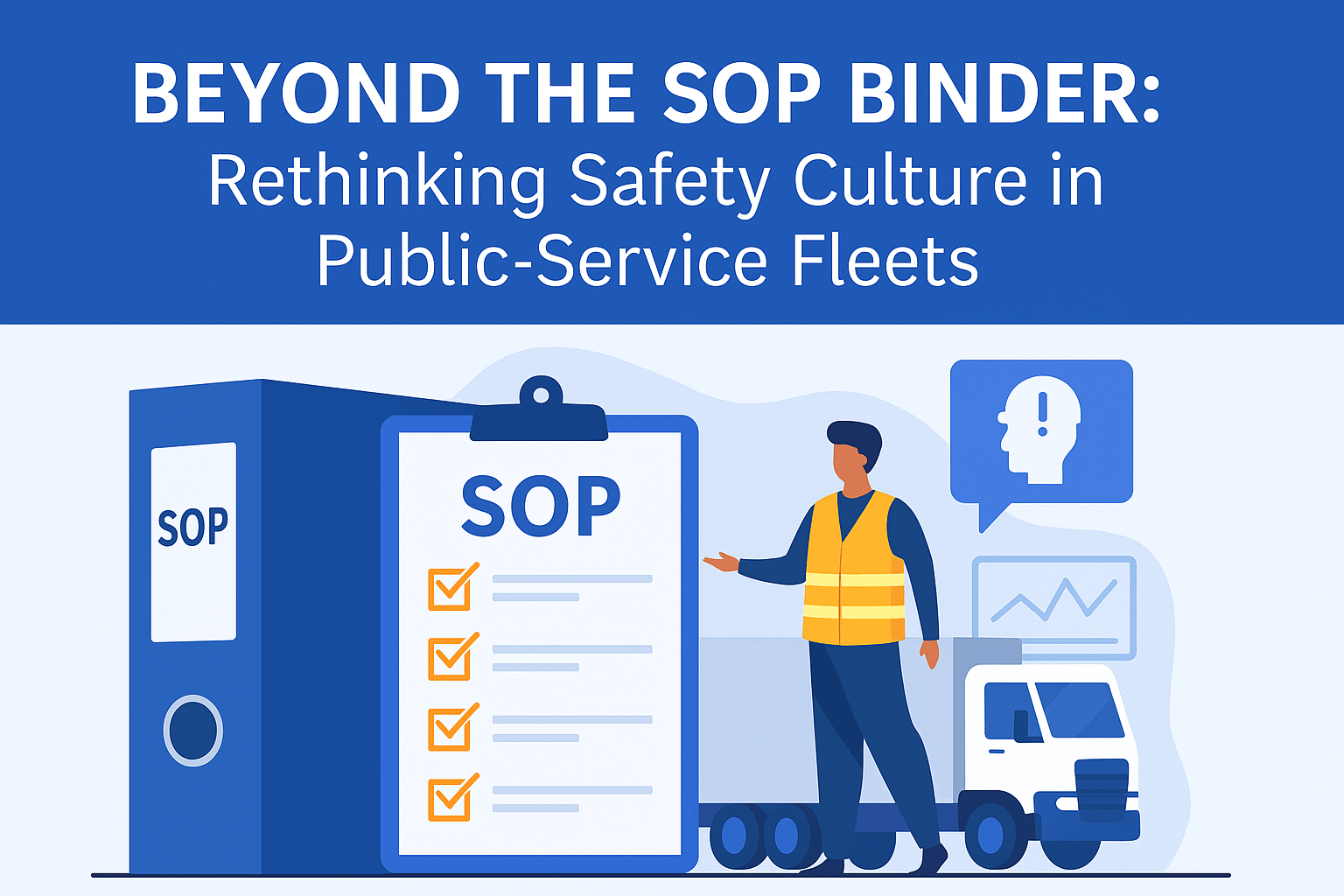
Rethinking Leading vs. Lagging Indicators in Fleet Risk Management
In the world of professional fleet operations, safety isn’t just a checkbox—it’s a competitive advantage. The ability to identify risk before it results in a crash, injury, or liability claim is the difference between being reactive and being resilient.
Unfortunately, many fleet safety programs still rely too heavily on lagging indicators—like incident reports or insurance claims—when the real opportunity lies in leading indicators that can predict accidents and allow for early intervention.
This article breaks down the fleet safety metrics that actually predict accidents, how to track them, and how to use them to build a data-driven, proactive safety culture across your organization.
The Problem with Lagging Indicators
Lagging indicators are useful for reporting past outcomes, but they tell you what happened, not why it happened or what to do next.
Common Lagging Indicators:
- Vehicle crashes
- Workers’ compensation claims
- OSHA recordables
- Vehicle damage reports
- Lost time due to injuries
These metrics are important for compliance and post-incident analysis—but by the time you’re reviewing them, the damage is already done.
What Are Leading Indicators?
Leading indicators are measurable actions or behaviors that correlate with increased risk—but happen before an accident or injury.
They help answer questions like:
- Are our drivers engaging in risky behaviors?
- Are we training effectively?
- Is our maintenance program reducing breakdown risks?
- Is our safety culture aligned with outcomes?
The power of leading indicators lies in predictive safety management—spotting patterns and stepping in before an incident occurs.
Top Leading Indicators That Predict Fleet Accidents
- Harsh Driving Events (Telematics Data)
Data from telematics systems (e.g., Samsara, Geotab, Verizon Connect) can detect:
- Harsh braking
- Rapid acceleration
- Hard cornering
- Excessive speed
- High RPM driving
Why it matters: These are precursors to loss-of-control incidents and have a statistically significant correlation with future crashes. Fleets that coach on this data can reduce accident rates by 20–40%.
- Hours of Service (HOS) Violations & Fatigue Metrics
Driving while fatigued is one of the most underreported causes of collisions.
Track:
- HOS violations
- Incomplete or manipulated logs
- Frequent driving near max legal limits
- Nighttime shift frequency
Why it matters: Drivers operating at the edge of legal or physical endurance are exponentially more likely to experience performance lapses, especially under pressure or in poor weather.
- Preventive Maintenance Compliance
Vehicles that miss PM schedules tend to fail at the worst times.
Key data points:
- % of vehicles current on PM schedule
- of deferred maintenance items
- Average response time to fault codes or DTCs
Why it matters: Unexpected breakdowns not only delay service—they often lead to unsafe roadside repairs, emergency maneuvers, or operator stress, all of which raise crash risk.
- Safety Training Completion and Quiz Scores
What percentage of your drivers are up to date on training? How well are they retaining it?
Track:
- Training completion rates
- Time since last safety module
- Post-training assessment scores
Why it matters: Training fatigue is real—but incomplete or low-quality training leaves gaps in driver awareness and readiness. Training without assessment = unchecked risk.
- Near Miss Reporting
Encouraging (and tracking) near miss reports gives insight into unsafe behaviors or conditions before they escalate.
Metrics to track:
- of near miss reports per 100,000 miles driven
- % of near misses resolved or addressed
- Time to follow-up
Why it matters: A declining near miss reporting rate often means employees feel discouraged or fear blame—both red flags for an unhealthy safety culture.
- Driver Feedback and Satisfaction Surveys
Disengaged drivers are more likely to take shortcuts, ignore warnings, or delay reporting issues.
Track:
- Safety culture ratings by region or team
- Driver satisfaction with vehicle condition, dispatching, and workloads
- Retention predictors: e.g., likelihood to recommend the company
Why it matters: Driver dissatisfaction is a leading indicator of risk—especially when paired with high turnover, fatigue, or workload spikes.
Combining Leading and Lagging Indicators for Actionable Insights
Leading and lagging indicators are most powerful when used together. For example:
| Lagging Indicator | Related Leading Indicators |
| High crash rate on Route A | Excessive speeding, HOS violations, poor route planning |
| Increased backing collisions | Lack of spotter usage, incomplete training, mirror damage |
| Frequent A/C system failures | Missed PM checks, ignored fault codes, driver complaints |
By connecting the dots, fleet managers can move from blame to strategy.
How to Operationalize Leading Safety Indicators
- Build a Safety Dashboard
Use your fleet management software or create a custom dashboard with tools like Power BI or Tableau to combine telematics, training, and HR data.
- Assign Ownership
Every metric needs an owner—whether it’s a regional safety manager, fleet supervisor, or driver coach.
- Set Thresholds and Triggers
Define what constitutes elevated risk and set up alerts. Example:
- 3+ harsh braking events in a week = coaching session required
- PM overdue by 10 days = flagged for dispatch restriction
- Reward Leading Behavior
Shift culture by incentivizing safe behavior, not just punishing unsafe outcomes. Use gamification, recognition programs, or monthly “zero alert” bonuses.
Thinking Outside the Box: Emerging Predictive Metrics
- Eye tracking + facial fatigue detection: Real-time in-cab cameras can detect signs of drowsiness or distraction.
- Seat occupancy sensors: Detect if seatbelts are being buckled immediately after ignition (a sign of “faking” compliance).
- Predictive AI scoring: Some platforms assign a risk score to each driver, factoring in hundreds of variables across time.
Final Thoughts: Proactive Safety Is the Future of Fleet Management
Relying solely on crash data and reports is like trying to drive forward while staring in the rearview mirror. By identifying and tracking the fleet safety metrics that predict accidents, managers can shift from reactive compliance to proactive prevention.
What gets measured gets managed—and what gets managed gets safer.
Fleet Safety Metrics Quick Reference:
Leading Indicators
- Harsh driving events
- HOS violations & fatigue patterns
- Preventive maintenance compliance
- Training completion & retention
- Near miss reporting
- Driver engagement & survey feedback
Lagging Indicators
- Crash frequency and severity
- OSHA recordables
- Damage reports
- Liability and claim cost







